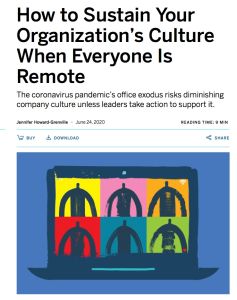Join getAbstract to access the summary!

Join getAbstract to access the summary!
Jennifer Howard-Grenville
How to Sustain Your Organization’s Culture When Everyone Is Remote
The coronavirus pandemic’s office exodus risks diminishing company culture unless leaders take action to support it.
MIT Sloan Management Review, 2020
What's inside?
Your company culture can grow stronger even as your staff works remotely.
Recommendation
Cambridge University Professor Jennifer Howard-Grenville explains in the MIT Sloan Management Review that corporate culture is much more than the physical elements of an office. With more people working remotely, companies must focus on the core elements of their culture in order to sustain it. While video meetings give employees less of an ability to emulate your company culture, managers can find ways to support and expand culture with remote workers. This article provides a useful backgrounder for managers who lead remote teams.
Take-Aways
- Working remotely long-term makes sustaining corporate culture difficult, but you can help your virtual workforce feel included.
- Corporate habits, not visible “artifacts,” are the basis of culture.
- Emphasize the elements of your company’s culture that have utility and meaning.
Summary
Working remotely long-term makes sustaining corporate culture difficult, but you can help your virtual workforce feel included.
Many observers lauded IBM for having 40% of its employees work remotely in 2009; eight years later, it brought “thousands” of staff members back to its physical offices. Now, the Covid-19 pandemic has sent many employees back home to work remotely, a situation that may become permanent for some.
“Even in today’s world of abundant online collaboration tools, there is often no substitute for co-presence.”
Giant IBM brought remote workers back together in its offices after eight years because its leaders realized that human in-office interaction supports corporate culture, creativity and problem solving. People understand one another better if they share non-verbal communication and common experiences. Without in-person interactions to cement a company’s shared “beliefs and practices,” managers and staff must innovate to highlight those mutual experiences. Unfortunately, written statements defining culture have little weight compared to living it.
Corporate habits, not visible “artifacts,” are the basis of culture.
You may miss the office lounge area while working at your kitchen table, but that “foosball” table is merely an “artifact” of your office – a device to encourage people to interact. The way people make decisions and collaborate defines a corporate culture. These often unstated, even unconscious practices form the company’s cultural “tool kit,” according to sociologist Ann Swidler. Your understanding of how and when to use these tools defines whether you are a member of the culture.
Company culture manifests in what people do. One oil company that defines itself as “entrepreneurial” has an ethos of “reactive problem-solving.” People who excel at switching priorities rapidly get promoted ahead of more “risk averse” people. Managers who are trying to preserve a corporate culture have to clarify these types of defining behaviors to remote staff members.
When a situation arises that is contrary to a managers’ corporate culture, they must decry that behavior. Their deep knowledge of the culture gives their opinions applicability and flexibility. Leaders also can ask staff members to help define corporate boundaries. This may require expanding your corporate tool kit or trying to make sure people use the elements it includes.
“We now understand organizational cultures to be much more open and interactive with their surrounding environments.”
During online meetings, you may find yourself adopting the tone teachers use to interact with children during online classes. That can change how you interact with your staff. Remember to address everyone as an adult. You can refer to current social movements to reiterate a corporate culture of inclusion. Work to incorporate social changes that align with your corporate culture in order to help it flourish.
Emphasize the elements of your company’s culture that have utility and meaning.
Use changing times to reinforce what’s important about your company. Often these are the firm’s foundational or starting ideals. Know why they matter. During hard times, these elements – the bedrock of company culture – can nourish and improve staff cohesion. For example, MIT’s “interdisciplinary, collaborative culture” started in response to its work on developing radar technology during WWII. Remembering its roots during the current pandemic will help the MIT community move forward.
“Not every aspect of culture is equally critical to guard.”
Changes a company intended to implement, such as decentralization, may occur too quickly in the current environment. To enable those changes and keep them effective, align them with your company’s culture. Be quick to identify and eliminate elements that run counter to that culture. Corporate culture is more difficult to maintain when most employees work from home, but with conscious actions, you can sustain it, apply it and help it flourish.
About the Author
Jennifer Howard-Grenville, a professor at the University of Cambridge’s business school, specializes in organizational studies and change.
This document is restricted to personal use only.























Comment on this summary